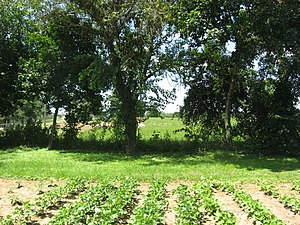Battle of Chillicothe
| Battle of Chillicothe | |||||||
|---|---|---|---|---|---|---|---|
| Part of the American Revolutionary War | |||||||
 A photograph of the site of Old Chillicothe | |||||||
| |||||||
| Belligerents | |||||||
|
| Shawnee | ||||||
| Commanders and leaders | |||||||
|
| Blackfish (DOW) | ||||||
| Strength | |||||||
| 296 militia | Unknown | ||||||
| Casualties and losses | |||||||
| 8 killed and 4 wounded[1] | 4–5 killed[2] | ||||||
The Battle of Chillicothe was a military engagement of the western theater of the American Revolutionary War. In May 1779, Colonel John Bowman of the Kentucky County militia, accompanied by Benjamin Logan and Levi Todd, led between 160 and 300 militiamen against the Shawnee settlement of Old Chillicothe.[3][4][5][6][7] Dividing their forces, Bowman and Logan attacked the town from two sides but were eventually repulsed. Unable to draw the Shawnee from their single blockhouse, Bowman burned much of the town and left with 163 horses valued at $32,000. Although initially blamed for a defeat, as well as the dozen casualties suffered by the Americans, Bowman and Logan were eventually credited by some with a major victory for the Patriots. With the destruction of a major Shawnee settlement and the death of Blackfish, additional war parties were discouraged from moving against American settlers in Kentucky.[8] According to Theodore Roosevelt in The Winning of the West, "the expedition undoubtedly accomplished more than Clark's attack on Piqua next year."[4]
References
[edit]- ^ Ohio Archaelogical and Historical Vol 19 pp.456-459
- ^ Ohio Archaelogical and Historical Vol 19 pp.456-459
- ^ "Bowman's Expedition Against Chillicothe: May-June, 1779" Ohio Archaeological and Historical Publications 19 (1910): 446–59.
- ^ a b Faust, Albert Bernhardt. The German Element in the United States, Vol. I. Boston and New York: Houghton Mifflin Co., 1909. (pg. 372)
- ^ Esarey, Logan. A History of Indiana: From its Exploration to 1850, Vol. I. Indianapolis: B.F. Bowen & Co., 1918. (pg. 88)
- ^ James, Alton James. George Rogers Clark Papers, 1771-1781. Virginia Series, Vol. III. Springfield, Illinois: Illinois State Historical Library, 1912.
- ^ Pieper, Thomas I and James B. Gidney. Fort Laurens, 1778-79: The Revolutionary War in Ohio. Kent, Ohio: Kent State University Press, 1980. (pg. 74) ISBN 0-87338-240-4
- ^ Zeisberger, David; Hermann Wellenreuther and Carola Wessel, ed. The Moravian Mission Diaries of David Zeisberger. University Park, Pennsylvania: Pennsylvania State University Press, 2005. (pg. 506) ISBN 0-271-02522-0
